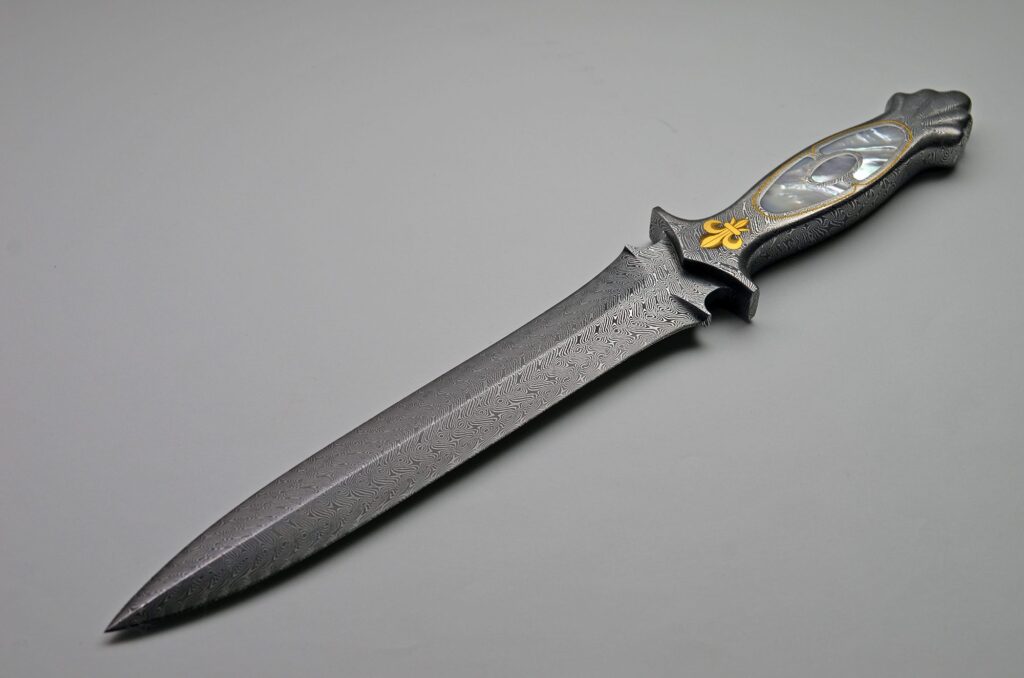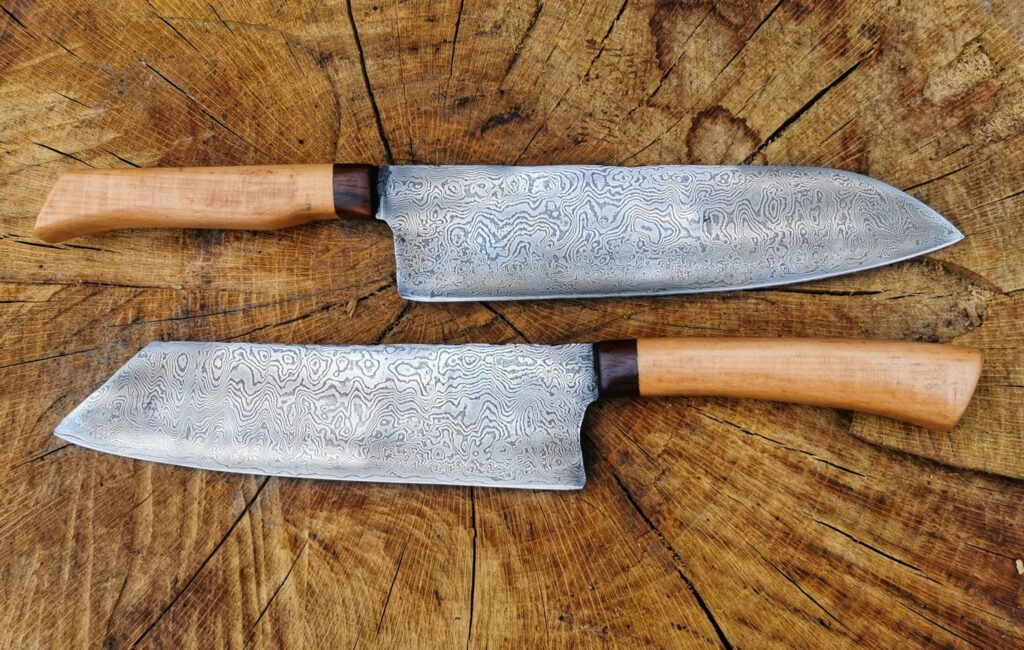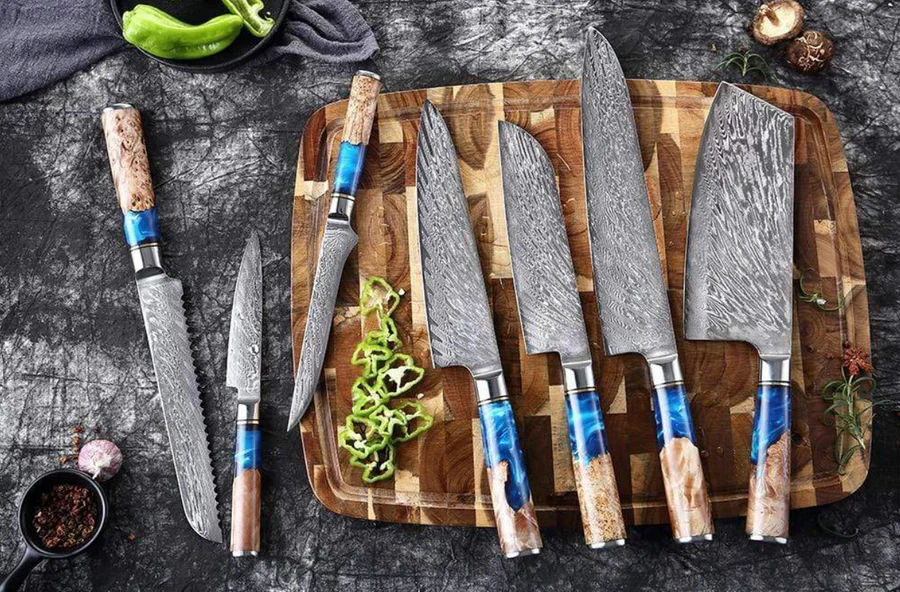You’ve probably heard the term “Damascus knife” if you enjoy knives or excellent blades. Damascus knives—what are they? This extensive page explores Damascus knives’ history, production, distinctive features, and more. Let’s explore with your favorite blade!
What is Damascus Knife?
Damascus knives are prized for their beauty, robustness, and sharpness. The fascinating swirling Damascus pattern on this blade is famous. Damascus knives have fascinated knife collectors since ancient times.
Damascus knives are made by carefully fusing different steel types. Craftsmanship and attention to detail create the blade’s amazing design. A strong, beautiful blade is created by continuously heating, folding, and hammering steel layers.
The History of Damascus Knives

Damascus knife history is mysterious. These blades have millennia of history. Damascus knives’ intriguing history awaits.
Ancient Origins
Damascus knives originated in the Middle East, North Africa, and India. Damascus steel dates to the 3rd century AD. These blacksmiths created strong, keen blades.
Damascus Steel Secrets
Damascus knife steel is fascinating. Damascus steel has legendary sharpness and endurance. Damascus steel’s initial composition and manufacturing methods are unknown.
Damascus Knives Return
Modern Damascus knife makers have restored the lost methods. new Damascus knives are beautiful and perform well thanks to study, experimentation, and new materials.
Damascus Knife Making

Damascus knives are painstakingly handcrafted. Let’s examine how these amazing blades are made.
Steel Choice
Damascus knives start with steel selection. To balance strength, flexibility, and beauty, two or more steels with different qualities are usually used.
Forge and Fold
The selected steel is heated and forged into a billet. Damascus knives produce layers and patterns by repeatedly heating, folding, and hammering the billet. This folding technique distributes carbon and other materials evenly along the blade.
Pattern Development
After forging and folding, the blade is heated, shaped, and ground to refine its design. The Damascus pattern begins to show, highlighting the blade’s beauty.
Heat Therapy
Damascus knives must be heat-treated. Controlling the temperature and time of heating and cooling improves the blade’s hardness, toughness, and performance. This procedure optimizes the qualities of the blade’s steels, resulting in a high-quality, useful, and beautiful knife.
Grind and polish
After heat treatment, the blade is ground and polished. To attain sharpness and beauty, this phase takes accuracy and care. The blade is polished to a mirror-like finish by skilled craftsmen.
Handle and Fittings
Damascus knives are designed and functioned by the blade, handle, and fittings. Wood, bone, horn, and synthetics are used to make handles. Handle material affects knife balance, grip, and feel.
The bolster and pommel give the knife structure and style. These brass, stainless steel, or other metal components are precisely sculpted and polished to match the blade and handle.
Unique Properties of Damascus Knives

Damascus knives have several distinctive qualities. Let’s examine Damascus knives’ most desirable traits:
Extreme Durability
Damascus knives are strong and durable due to multilayer structure and forging. The blade’s numerous steel layers make it durable and sharp.
Appealing Appearance
Damascus knives have stunning designs. The blade’s swirls, waves, and mosaics are stunning. Collectors and aficionados love Damascus knives because each blade is unique.
High-Quality Cutting
Damascus knives excel in cutting. High-quality steel and meticulous craftsmanship create a blade that stays sharp. Chefs and foodies love Damascus knives because they make slicing, chopping, and precision cutting easy.
Corrosion Resistance
Damascus knives’ steel makes them corrosion-resistant. Nickel and chromium in Damascus steel prevent rust and preserve the blade in damp or corrosive situations.
Damascus Knives FAQ
Damascus knives—only for decoration?
Damascus knives are functional. Damascus knives are beautiful and practical. They are beautiful and perform well in culinary, outdoor, and daily use.
Damascus knives—difficult to maintain?
Damascus knife care is simple. To avoid moisture difficulties, wash the blade with warm water and mild soap after each use and dry it quickly. Oiling the blade regularly prevents rust. Damascus knives can last a lifetime with proper care.
Damascus knives: sharpenable?
Damascus knives may be sharpened like any other. To retain the Damascus pattern, employ proper sharpening equipment and methods. For best results, use a Damascus-trained knife sharpener.
Damascus knives—handmade?
Modern manufacturing methods allow Damascus knives to be mass-produced. However, many knife aficionados and collectors prefer handcrafted Damascus knives for their uniqueness, attention to detail, and artisanal touch.
Damascus knives for outdoors?
Damascus knives work nicely outdoors. Camping, hunting, and survival are perfect for their strength, durability, and sharpness. Damascus knives work well in harsh outdoor circumstances.
All Damascus knives expensive?
Damascus knives vary in price according on materials, craftsmanship, and maker reputation. Damascus knives can be pricey, but there are cheaper options. Research and select a Damascus knife that fits your budget and needs.
Conclusion
Damascus knives are art. Knife fans and collectors worldwide love their rich history, gorgeous patterns, and remarkable performance. Damascus knives are ideal for cutting or looking good.
Next time you handle a Damascus knife, admire its craftsmanship and centuries-old tradition. It shows human invention, talent, and the blade’s lasting appeal.
